Journal Description
Agriculture
Agriculture
is an international, scientific peer-reviewed open access journal published semimonthly online by MDPI.
- Open Access— free for readers, with article processing charges (APC) paid by authors or their institutions.
- High Visibility: indexed within Scopus, SCIE (Web of Science), PubAg, AGRIS, RePEc, and other databases.
- Journal Rank: JCR - Q1 (Agronomy) / CiteScore - Q1 (Plant Science)
- Rapid Publication: manuscripts are peer-reviewed and a first decision is provided to authors approximately 18 days after submission; acceptance to publication is undertaken in 1.9 days (median values for papers published in this journal in the first half of 2025).
- Recognition of Reviewers: reviewers who provide timely, thorough peer-review reports receive vouchers entitling them to a discount on the APC of their next publication in any MDPI journal, in appreciation of the work done.
- Companion journals for Agriculture include: Poultry, Grasses and Crops.
Impact Factor:
3.6 (2024);
5-Year Impact Factor:
3.8 (2024)
Latest Articles
Plastic Film Mulching Regulates Soil Respiration and Temperature Sensitivity in Maize Farming Across Diverse Hydrothermal Conditions
Agriculture 2025, 15(15), 1667; https://doi.org/10.3390/agriculture15151667 (registering DOI) - 1 Aug 2025
Abstract
Soil respiration (Rt), consisting of heterotrophic (Rh) and autotrophic respiration (Ra), plays a vital role in terrestrial carbon cycling and is sensitive to soil temperature and moisture. In dryland agriculture, plastic film mulching (PM) is widely used to regulate soil hydrothermal conditions, but
[...] Read more.
Soil respiration (Rt), consisting of heterotrophic (Rh) and autotrophic respiration (Ra), plays a vital role in terrestrial carbon cycling and is sensitive to soil temperature and moisture. In dryland agriculture, plastic film mulching (PM) is widely used to regulate soil hydrothermal conditions, but its effects on Rt components and their temperature sensitivity (Q10) across regions remain unclear. A two-year field study was conducted at two rain-fed maize sites: Anding (warmer, semi-arid) and Yuzhong (colder, drier). PM significantly increased Rt, Rh, and Ra, especially Ra, due to enhanced root biomass and improved microclimate. Yield increased by 33.6–165%. Peak respiration occurred earlier in Anding, aligned with maize growth and soil temperature. PM reduced Q10 of Rt and Ra in Anding, but only Ra in Yuzhong. Rh Q10 remained stable, indicating microbial respiration was less sensitive to temperature changes. Structural equation modeling revealed that Rt and Ra were mainly driven by soil temperature and root biomass, while Rh was more influenced by microbial biomass carbon (MBC) and dissolved organic carbon (DOC). Despite increased CO2 emissions, PM improved carbon emission efficiency (CEE), particularly in Yuzhong (+67%). The application of PM is recommended to enhance yield while optimizing carbon efficiency in dryland farming systems.
Full article
(This article belongs to the Topic Advances in Water and Soil Management Towards Climate Change Adaptation)
►
Show Figures
Open AccessArticle
Native Grass Enhances Bird, Dragonfly, Butterfly and Plant Biodiversity Relative to Conventional Crops in Midwest, USA
by
Steven I. Apfelbaum, Susan M. Lehnhardt, Michael Boston, Lea Daly, Gavin Pinnow, Kris Gillespie and Donald M. Waller
Agriculture 2025, 15(15), 1666; https://doi.org/10.3390/agriculture15151666 (registering DOI) - 1 Aug 2025
Abstract
Conspicuous declines in native grassland habitats have triggered sharp reductions in grassland birds, dragonflies, butterflies, and native plant populations and diversity. We compared these biotic groups among three crop type treatments: corn, alfalfa, and a perennial native grass, Virginia wild rye, (Elymus
[...] Read more.
Conspicuous declines in native grassland habitats have triggered sharp reductions in grassland birds, dragonflies, butterflies, and native plant populations and diversity. We compared these biotic groups among three crop type treatments: corn, alfalfa, and a perennial native grass, Virginia wild rye, (Elymus virginicus L.) or VWR. This crop type had 2-3X higher bird, dragonfly, butterfly and plant species richness, diversity, and faunal abundance relative to alfalfa and corn types. VWR crop fields also support more obligate grassland bird species and higher populations of dragonfly and butterfly species associated with grasslands and wet meadows. In contrast, the corn and alfalfa types support few or no obligatory grassland birds and mostly non-native insects such as the white cabbage looper (Artogeia rapae L.), the common yellow sulfur butterfly (Colias philodice Godart.), and the mobile and migratory common green darner dragonfly (Anax junius Drury.). In sum, the VWR perennial native grass crop type offers a special opportunity to improve the diversity and abundance of grassland bird species, beneficial insect species, and many native plant species within agricultural landscapes.
Full article
(This article belongs to the Section Agricultural Systems and Management)
►▼
Show Figures
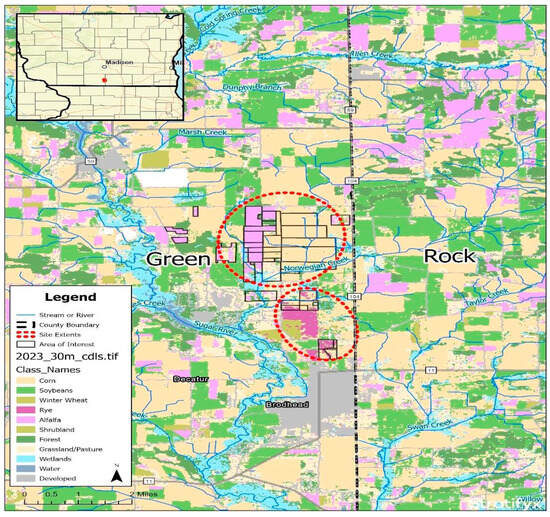
Figure 1
Open AccessArticle
Colony Nutrition Enhances Bee Resilience to Fungicides, While the Benefit of Propolis Supplementation Depends on Stress Conditions
by
Yara Martins Molina Ferraz, Aline Yukari Kato, Tainá Angelica de Lima Freitas, Cássia Regina de Avelar Gomes, Thais Regina Ramos Alves, Matheus Franco Trivellato, Samir Moura Kadri, Ricardo de Oliveira Orsi, David De Jong, Jaqueline Dalbello Biller and Daniel Nicodemo
Agriculture 2025, 15(15), 1665; https://doi.org/10.3390/agriculture15151665 (registering DOI) - 1 Aug 2025
Abstract
Enhanced colony nutrition can support brood development, resulting in better physiological conditions and increased resilience in adult honey bees, particularly under stress. This study investigated the effects of colony nutrition and adult dietary supplementation with green propolis on bee health under fungicide exposure.
[...] Read more.
Enhanced colony nutrition can support brood development, resulting in better physiological conditions and increased resilience in adult honey bees, particularly under stress. This study investigated the effects of colony nutrition and adult dietary supplementation with green propolis on bee health under fungicide exposure. Colonies were managed under food restriction or nutritional supplementation for 22 weeks. Newly emerged bees from each colony were then caged and fed protein diets consisting of honey-pollen patties contaminated or not with fungicide, and sucrose sugar syrup with or without aqueous green propolis extract. Bees from supplemented colonies showed greater body weight, higher hemolymph protein levels, and higher consumption of protein food after seven days in cages. Fungicide exposure reduced hemolymph protein levels, altered the expression of detoxification and immune-related genes, and significantly decreased bee survival. Interestingly, propolis supplementation alone changed gene expression patterns and slightly reduced longevity compared to bees not exposed to propolis or fungicide. However, under fungicide stress, bees that ingested propolis survived longer, indicating a protective effect. While colony nutritional supplementation clearly promotes honey bee resilience against fungicide exposure, feeding propolis also showed promising effects, though further studies are needed to determine an optimal dietary concentration.
Full article
(This article belongs to the Special Issue Honey Bees and Wild Pollinators in Agricultural Ecosystems)
►▼
Show Figures
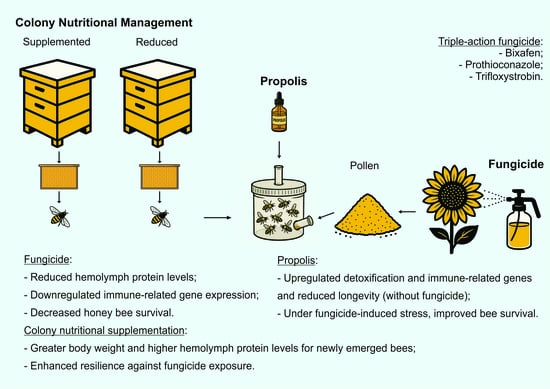
Graphical abstract
Open AccessReview
Technology Advancements and the Needs of Farmers: Mapping Gaps and Opportunities in Row Crop Farming
by
Rana Umair Hameed, Conor Meade and Gerard Lacey
Agriculture 2025, 15(15), 1664; https://doi.org/10.3390/agriculture15151664 (registering DOI) - 1 Aug 2025
Abstract
Increased food production demands, labor shortages, and environmental concerns are driving the need for innovative agricultural technologies. However, effective adoption depends critically on aligning robot innovations with the needs of farmers. This paper examines the alignment between the needs of farmers and the
[...] Read more.
Increased food production demands, labor shortages, and environmental concerns are driving the need for innovative agricultural technologies. However, effective adoption depends critically on aligning robot innovations with the needs of farmers. This paper examines the alignment between the needs of farmers and the robotic systems used in row crop farming. We review current commercial agricultural robots and research, and map these to the needs of farmers, as expressed in the literature, to identify the key issues holding back large-scale adoption. From initial pool of 184 research articles, 19 survey articles, and 82 commercial robotic solutions, we selected 38 peer-reviewed academic studies, 12 survey articles, and 18 commercially available robots for in-depth review and analysis for this study. We identify the key challenges faced by farmers and map them directly to the current and emerging capabilities of agricultural robots. We supplement the data gathered from the literature review of surveys and case studies with in-depth interviews with nine farmers to obtain deeper insights into the needs and day-to-day operations. Farmers reported mixed reactions to current technologies, acknowledging efficiency improvements but highlighting barriers such as capital costs, technical complexity, and inadequate support systems. There is a notable demand for technologies for improved plant health monitoring, soil condition assessment, and enhanced climate resilience. We then review state-of-the-art robotic solutions for row crop farming and map these technological capabilities to the farmers’ needs. Only technologies with field validation or operational deployment are included, to ensure practical relevance. These mappings generate insights that underscore the need for lightweight and modular robot technologies that can be adapted to diverse farming practices, as well as the need for farmers’ education and simpler interfaces to robotic operations and data analysis that are actionable for farmers. We conclude with recommendations for future research, emphasizing the importance of co-creation with the farming community to ensure the adoption and sustained use of agricultural robotic solutions.
Full article
(This article belongs to the Section Artificial Intelligence and Digital Agriculture)
►▼
Show Figures
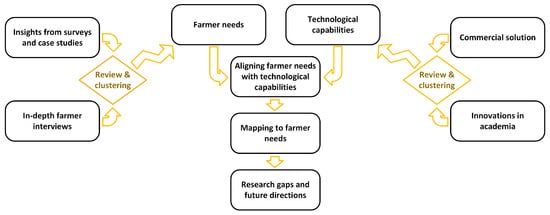
Figure 1
Open AccessArticle
Tractor Path Tracking Control Method Based on Prescribed Performance and Sliding Mode Control
by
Liwei Zhu, Weiming Sun, Qian Zhang, En Lu, Jialin Xue and Guohui Sha
Agriculture 2025, 15(15), 1663; https://doi.org/10.3390/agriculture15151663 - 1 Aug 2025
Abstract
In addressing the challenges of low path tracking accuracy and poor robustness during tractor autonomous operation, this paper proposes a path tracking control method for tractors that integrates prescribed performance with sliding mode control (SMC). A key feature of this control method is
[...] Read more.
In addressing the challenges of low path tracking accuracy and poor robustness during tractor autonomous operation, this paper proposes a path tracking control method for tractors that integrates prescribed performance with sliding mode control (SMC). A key feature of this control method is its inherent immunity to system parameter perturbations and external disturbances, while ensuring path tracking errors are constrained within a predefined range. First, the tractor is simplified into a two-wheeled vehicle model, and a path tracking error model is established based on the reference operation trajectory. By defining a prescribed performance function, the constrained tracking control problem is transformed into an unconstrained stability control problem, guaranteeing the boundedness of tracking errors. Then, by incorporating SMC theory, a prescribed performance sliding mode path tracking controller is designed to achieve robust path tracking and error constraint for the tractor. Finally, both simulation and field experiments are conducted to validate the method. The results demonstrate that compared with the traditional SMC method, the proposed method effectively mitigates the impact of complex farmland conditions, reducing path tracking errors while enforcing strict error constraints. Field experiment data shows the proposed method achieves an average absolute error of 0.02435 m and a standard deviation of 0.02795 m, confirming its effectiveness and superiority. This research lays a foundation for the intelligent development of agricultural machinery.
Full article
(This article belongs to the Section Agricultural Technology)
►▼
Show Figures
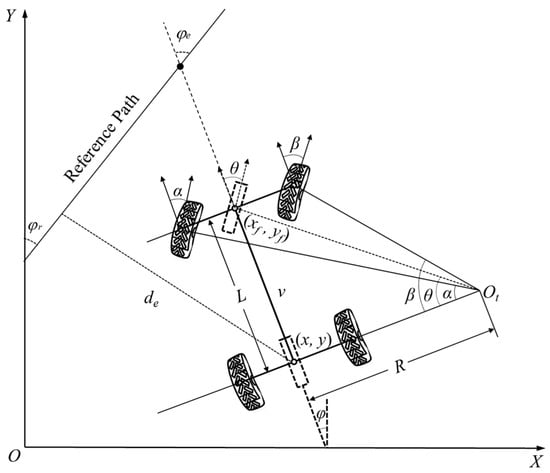
Figure 1
Open AccessArticle
Multi-Trait Phenotypic Analysis and Biomass Estimation of Lettuce Cultivars Based on SFM-MVS
by
Tiezhu Li, Yixue Zhang, Lian Hu, Yiqiu Zhao, Zongyao Cai, Tingting Yu and Xiaodong Zhang
Agriculture 2025, 15(15), 1662; https://doi.org/10.3390/agriculture15151662 - 1 Aug 2025
Abstract
To address the problems of traditional methods that rely on destructive sampling, the poor adaptability of fixed equipment, and the susceptibility of single-view angle measurements to occlusions, a non-destructive and portable device for three-dimensional phenotyping and biomass detection in lettuce was developed. Based
[...] Read more.
To address the problems of traditional methods that rely on destructive sampling, the poor adaptability of fixed equipment, and the susceptibility of single-view angle measurements to occlusions, a non-destructive and portable device for three-dimensional phenotyping and biomass detection in lettuce was developed. Based on the Structure-from-Motion Multi-View Stereo (SFM-MVS) algorithms, a high-precision three-dimensional point cloud model was reconstructed from multi-view RGB image sequences, and 12 phenotypic parameters, such as plant height, crown width, were accurately extracted. Through regression analyses of plant height, crown width, and crown height, and the R2 values were 0.98, 0.99, and 0.99, respectively, the RMSE values were 2.26 mm, 1.74 mm, and 1.69 mm, respectively. On this basis, four biomass prediction models were developed using Adaptive Boosting (AdaBoost), Support Vector Regression (SVR), Gradient Boosting Decision Tree (GBDT), and Random Forest Regression (RFR). The results indicated that the RFR model based on the projected convex hull area, point cloud convex hull surface area, and projected convex hull perimeter performed the best, with an R2 of 0.90, an RMSE of 2.63 g, and an RMSEn of 9.53%, indicating that the RFR was able to accurately simulate lettuce biomass. This research achieves three-dimensional reconstruction and accurate biomass prediction of facility lettuce, and provides a portable and lightweight solution for facility crop growth detection.
Full article
(This article belongs to the Section Crop Production)
►▼
Show Figures

Figure 1
Open AccessArticle
Does Digital Literacy Increase Farmers’ Willingness to Adopt Livestock Manure Resource Utilization Modes: An Empirical Study from China
by
Xuefeng Ma, Yahui Li, Minjuan Zhao and Wenxin Liu
Agriculture 2025, 15(15), 1661; https://doi.org/10.3390/agriculture15151661 - 1 Aug 2025
Abstract
Enhancing farmers’ digital literacy is both an inevitable requirement for adapting to the digital age and an important measure for promoting the sustainable development of livestock and poultry manure resource utilization. This study surveyed and obtained data from 1047 farm households in Ningxia
[...] Read more.
Enhancing farmers’ digital literacy is both an inevitable requirement for adapting to the digital age and an important measure for promoting the sustainable development of livestock and poultry manure resource utilization. This study surveyed and obtained data from 1047 farm households in Ningxia and Gansu, two provinces in China that have long implemented livestock manure resource utilization policies, from December 2023 to January 2024, and employed the binary probit model to analyze how digital literacy influences farmers’ willingness to adopt two livestock manure resource utilization modes, as well as to analyze the moderating role of three policy regulations. This paper also explores the heterogeneous results in different village forms and income groups. The results are as follows: (1) Digital literacy significantly and positively impacts farmers’ willingness to adopt both the “household collection” mode and the “livestock community” mode. For every one-unit increase in a farmer’s digital literacy, the probability of farmers’ willingness to adopt the “household collection” mode rises by 22 percentage points, and the probability of farmers’ willingness to adopt the “livestock community” mode rises by 19.8 percentage points. After endogeneity tests and robustness checks, the conclusion still holds. (2) Mechanism analysis results indicate that guiding policy and incentive policy have a positive moderation effect on the link between digital literacy and the willingness to adopt the “household collection” mode. Meanwhile, incentive policy also positively moderates the relationship between digital literacy and the willingness to adopt the “livestock community” mode. (3) Heterogeneity analysis results show that the positive effect of digital literacy on farmers’ willingness to adopt two livestock manure resource utilization modes is stronger in “tight-knit society” rural areas and in low-income households. (4) In further discussion, we find that digital literacy removes the information barriers for farmers, facilitating the conversion of willingness into behavior. The value of this study is as follows: this paper provides new insights for the promotion of livestock and poultry manure resource utilization policies in countries and regions similar to the development process of northwest China. Therefore, enhancing farmers’ digital literacy in a targeted way, strengthening the promotion of grassroots policies on livestock manure resource utilization, formulating diversified ecological compensation schemes, and establishing limited supervision and penalty rules can boost farmers’ willingness to adopt manure resource utilization models.
Full article
(This article belongs to the Special Issue Application of Biomass in Agricultural Circular Economy)
►▼
Show Figures

Figure 1
Open AccessArticle
Optimization of Greenhouse Structure Parameters Based on Temperature and Velocity Distribution Characteristics by CFD—A Case Study in South China
by
Xinyu Wei, Yizhi Ou, Ziwei Li, Jiaming Guo, Enli Lü, Fengxi Yang, Yanhua Liu and Bin Li
Agriculture 2025, 15(15), 1660; https://doi.org/10.3390/agriculture15151660 - 1 Aug 2025
Abstract
Greenhouses are applied to mitigate the deleterious effects of inclement weather, which facilitates the optimal growth and development of the crops. South China has a climate characterized by high temperature and high humidity, and the temperature and relative humidity inside a Venlo greenhouse
[...] Read more.
Greenhouses are applied to mitigate the deleterious effects of inclement weather, which facilitates the optimal growth and development of the crops. South China has a climate characterized by high temperature and high humidity, and the temperature and relative humidity inside a Venlo greenhouse are higher than those in the atmosphere. In this paper, the numerical model of the flow distribution of a Venlo greenhouse in South China was established using the CFD method, which mainly applied the DO model, the k-e turbulence model, and the porous medium model. The porous resistance characteristics of tomatoes were obtained through experimental research. The inertial resistances of tomato plants in the x, y, and z directions were 80,000,000, 18,000,000, and 120,000,000, respectively; the viscous resistances of tomato plants in the x, y, and z directions were 0.43, 0.60, and 0.63, respectively. The porosity of tomato plants was 0.996. The average difference between the temperature of the established numerical model and the experimental temperature was less than 0.11 °C, and the average relative error was 2.72%. This research also studied the effects of five management and structure parameters on the velocity and temperature distribution in a greenhouse. The optimal inlet velocity is 1.32 m/s, with the COF of velocity and temperature being 9.23% and 1.18%, respectively. The optimal skylight opening is 1.76 m, with the COF of velocity and temperature being 10.68% and 0.88%, respectively. The optimal side window opening is 0.67 m, with the COF of velocity and temperature being 9.25% and 2.10%, respectively. The optimal side window height is 1.18 m, with the COF of velocity and temperature being 9.50% and 1.33%, respectively. The optimal planting interval is 1.40 m, with the COF of velocity and temperature being 15.29% and 0.20%, respectively. The results provide a reference for the design and management of Venlo greenhouses in South China.
Full article
(This article belongs to the Special Issue Research on Plant Production in Greenhouse and Plant Factory Systems—2nd Edition)
►▼
Show Figures

Figure 1
Open AccessCorrection
Correction: Lin et al. Research on Machine Learning Models for Maize Hardness Prediction Based on Indentation Test. Agriculture 2024, 14, 224
by
Haipeng Lin, Xuefeng Song, Fei Dai, Fengwei Zhang, Qiang Xie and Huhu Chen
Agriculture 2025, 15(15), 1659; https://doi.org/10.3390/agriculture15151659 - 1 Aug 2025
Abstract
In the original publication [...]
Full article
(This article belongs to the Special Issue Agricultural Products Processing and Quality Detection)
Open AccessArticle
Positive Effects of Reduced Tillage Practices on Earthworm Population Detected in the Early Transition Period
by
Irena Bertoncelj, Anže Rovanšek and Robert Leskovšek
Agriculture 2025, 15(15), 1658; https://doi.org/10.3390/agriculture15151658 - 1 Aug 2025
Abstract
Tillage is a major factor influencing soil biological communities, particularly earthworms, which play a key role in soil structure and nutrient cycling. To address soil degradation, less-intensive tillage practices are increasingly being adopted globally and have shown positive effects on earthworm populations when
[...] Read more.
Tillage is a major factor influencing soil biological communities, particularly earthworms, which play a key role in soil structure and nutrient cycling. To address soil degradation, less-intensive tillage practices are increasingly being adopted globally and have shown positive effects on earthworm populations when applied consistently over extended periods. However, understanding of the earthworm population dynamics in the period following the implementation of changes in tillage practices remains limited. This three-year field study (2021–2023) investigates earthworm populations during the early transition phase (4–6 years) following the conversion from conventional ploughing to conservation (<8 cm depth, with residue retention) and no-tillage systems in a temperate arable system in central Slovenia. Earthworms were sampled annually in early October from three adjacent fields, each following the same three-year crop rotation (maize—winter cereal + cover crop—soybeans), using a combination of hand-sorting and allyl isothiocyanate (AITC) extraction. Results showed that reduced tillage practices significantly increased both earthworm biomass and abundance compared to conventional ploughing. However, a significant interaction between tillage and year was observed, with a sharp decline in earthworm abundance and mass in 2022, likely driven by a combination of 2022 summer tillage prior to cover crop sowing and extreme drought conditions. Juvenile earthworms were especially affected, with their proportion decreasing from 62% to 34% in ploughed plots and from 63% to 26% in conservation tillage plots. Despite interannual fluctuations, no-till showed the lowest variability in earthworm population. Long-term monitoring is essential to disentangle management and environmental effects and to inform resilient soil management strategies.
Full article
(This article belongs to the Section Agricultural Soils)
►▼
Show Figures

Figure 1
Open AccessArticle
Combined Effects of Polyethylene and Bordeaux Mixture on the Soil–Plant System: Phytotoxicity, Copper Accumulation and Changes in Microbial Abundance
by
Silvia Romeo-Río, Huguette Meta Foguieng, Antía Gómez-Armesto, Manuel Conde-Cid, David Fernández-Calviño and Andrés Rodríguez-Seijo
Agriculture 2025, 15(15), 1657; https://doi.org/10.3390/agriculture15151657 - 1 Aug 2025
Abstract
Greenhouses have positively impacted plant production by allowing the cultivation of different crops per year. However, the accumulation of agricultural plastics, potentially contaminated with agrochemicals, raises environmental concerns. This work evaluates the combined effect of Bordeaux mixture and low-density polyethylene (LDPE) microplastics (<5
[...] Read more.
Greenhouses have positively impacted plant production by allowing the cultivation of different crops per year. However, the accumulation of agricultural plastics, potentially contaminated with agrochemicals, raises environmental concerns. This work evaluates the combined effect of Bordeaux mixture and low-density polyethylene (LDPE) microplastics (<5 mm) on the growth of lettuce (Lactuca sativa L.) and soil microbial communities. Different levels of Bordeaux mixture (0, 100 and 500 mg kg−1), equivalent to Cu(II) concentrations (0, 17 and 83 mg kg−1), LDPE microplastics (0, 1% and 5%) and their combination were selected. After 28 days of growth, biometric and photosynthetic parameters, Cu uptake, and soil microbial responses were evaluated. Plant germination and growth were not significantly affected by the combination of Cu and plastics. However, individual Cu treatments influenced root and shoot length and biomass. Chlorophyll and carotenoid concentrations increased with Cu addition, although the differences were not statistically significant. Phospholipid fatty acid (PLFA) analysis revealed a reduction in microbial biomass at the highest Cu dose, whereas LDPE alone showed limited effects and may reduce Cu bioavailability. These results suggest that even at the highest concentration added, Cu can act as a plant nutrient, while the combination of Cu–plastics showed varying effects on plant growth and soil microbial communities.
Full article
(This article belongs to the Special Issue Impacts of Emerging Agricultural Pollutants on Environmental Health)
►▼
Show Figures

Figure 1
Open AccessArticle
Solar Agro Savior: Smart Agricultural Monitoring Using Drones and Deep Learning Techniques
by
Manu Mundappat Ramachandran, Bisni Fahad Mon, Mohammad Hayajneh, Najah Abu Ali and Elarbi Badidi
Agriculture 2025, 15(15), 1656; https://doi.org/10.3390/agriculture15151656 - 1 Aug 2025
Abstract
The Solar Agro Savior (SAS) is an innovative solution that is assisted by drones for the sustainable utilization of water and plant disease observation in the agriculture sector. This system integrates an alerting mechanism for humidity, moisture, and temperature variations, which affect the
[...] Read more.
The Solar Agro Savior (SAS) is an innovative solution that is assisted by drones for the sustainable utilization of water and plant disease observation in the agriculture sector. This system integrates an alerting mechanism for humidity, moisture, and temperature variations, which affect the plants’ health and optimization in water utilization, which enhances plant yield productivity. A significant feature of the system is the efficient monitoring system in a larger region through drones’ high-resolution cameras, which enables real-time, efficient response and alerting for environmental fluctuations to the authorities. The machine learning algorithm, particularly recurrent neural networks, which is a pioneer with agriculture and pest control, is incorporated for intelligent monitoring systems. The proposed system incorporates a specialized form of a recurrent neural network, Long Short-Term Memory (LSTM), which effectively addresses the vanishing gradient problem. It also utilizes an attention-based mechanism that enables the model to assign meaningful weights to the most important parts of the data sequence. This algorithm not only enhances water utilization efficiency but also boosts plant yield and strengthens pest control mechanisms. This system also provides sustainability through the re-utilization of water and the elimination of electric energy through solar panel systems for powering the inbuilt irrigation system. A comparative analysis of variant algorithms in the agriculture sector with a machine learning approach was also illustrated, and the proposed system yielded 99% yield accuracy, a 97.8% precision value, 98.4% recall, and a 98.4% F1 score value. By encompassing solar irrigation and artificial intelligence-driven analysis, the proposed algorithm, Solar Argo Savior, established a sustainable framework in the latest agricultural sectors and promoted sustainability to protect our environment and community.
Full article
(This article belongs to the Section Agricultural Technology)
►▼
Show Figures

Figure 1
Open AccessArticle
Nonlinear Narrowband Active Noise Control for Tractors Based on a Momentum-Enhanced Volterra Filter
by
Tao Zhang, Zhixuan Guan, Shuai Zhang, Kai Song and Boyan Huang
Agriculture 2025, 15(15), 1655; https://doi.org/10.3390/agriculture15151655 - 1 Aug 2025
Abstract
Nonlinear narrowband low-frequency noise generated during tractors’ operation significantly affects operators’ comfort and working efficiency. Traditional linear active noise control algorithms often struggle to effectively suppress such complex acoustic disturbances. To address this challenge, this paper proposes a momentum-enhanced Volterra filter-based active noise
[...] Read more.
Nonlinear narrowband low-frequency noise generated during tractors’ operation significantly affects operators’ comfort and working efficiency. Traditional linear active noise control algorithms often struggle to effectively suppress such complex acoustic disturbances. To address this challenge, this paper proposes a momentum-enhanced Volterra filter-based active noise control (ANC) algorithm that improves both the modeling capability of nonlinear acoustic paths and the convergence performance of the system. The proposed approach integrates the nonlinear representation power of the Volterra filter with a momentum optimization mechanism to enhance convergence speed while maintaining robust steady-state accuracy. Simulations are conducted under second- and third-order nonlinear primary paths, followed by performance validation using multi-tone signals and real in-cabin tractor noise recordings. The results demonstrate that the proposed algorithm achieves superior performance, reducing the NMSE to approximately −35 dB and attenuating residual noise energy by 3–5 dB in the 200–800 Hz range, compared to FXLMS and VFXLMS algorithms. The findings highlight the algorithm’s potential for practical implementation in nonlinear and narrowband active noise control scenarios within complex mechanical environments.
Full article
(This article belongs to the Section Agricultural Technology)
►▼
Show Figures

Figure 1
Open AccessArticle
Impact of Nitrogen Fertilisation and Inoculation on Soybean Nodulation, Nitrogen Status, and Yield in a Central European Climate
by
Waldemar Helios, Magdalena Serafin-Andrzejewska, Marcin Kozak and Sylwia Lewandowska
Agriculture 2025, 15(15), 1654; https://doi.org/10.3390/agriculture15151654 - 1 Aug 2025
Abstract
Soybean (Glycine max [L.] Merr.) cultivation is expanding in Central Europe due to the development of early-maturing cultivars and growing demand for plant-based protein produced without the use of genetically modified organisms. However, nitrogen (N) management remains a major challenge in temperate
[...] Read more.
Soybean (Glycine max [L.] Merr.) cultivation is expanding in Central Europe due to the development of early-maturing cultivars and growing demand for plant-based protein produced without the use of genetically modified organisms. However, nitrogen (N) management remains a major challenge in temperate climates, where variable weather conditions can significantly affect nodulation and yield. This study evaluated the effects of three nitrogen fertilisation doses (0, 30, and 60 kg N·ha−1), applied in the form of ammonium nitrate (34% N) and two commercial rhizobial inoculants—HiStick Soy (containing Bradyrhizobium japonicum strain 532C) and Nitragina (including a Polish strain of B. japonicum)—on nodulation, nitrogen uptake, and seed yield. A three-year field experiment (2017–2019) was conducted in southwestern Poland using a two-factor randomized complete block design. Nodulation varied significantly across years, with the highest values recorded under favourable early-season moisture and reduced during drought. In the first year, inoculation with HiStick Soy significantly increased nodule number and seed yield compared to Nitragina and the uninoculated control. Nitrogen fertilisation consistently improved seed yield, although it had no significant effect on nodulation. The highest nitrogen use efficiency was observed with moderate nitrogen input (30 kg N·ha−1) combined with inoculation. These findings highlight the importance of integrating effective rhizobial inoculants with optimized nitrogen fertilisation to improve soybean productivity and nitrogen efficiency under variable temperate climate conditions.
Full article
(This article belongs to the Special Issue Strategies to Enhance Nutrient Use Efficiency and Crop Nutrition)
►▼
Show Figures

Figure 1
Open AccessArticle
MSMT-RTDETR: A Multi-Scale Model for Detecting Maize Tassels in UAV Images with Complex Field Backgrounds
by
Zhenbin Zhu, Zhankai Gao, Jiajun Zhuang, Dongchen Huang, Guogang Huang, Hansheng Wang, Jiawei Pei, Jingjing Zheng and Changyu Liu
Agriculture 2025, 15(15), 1653; https://doi.org/10.3390/agriculture15151653 - 31 Jul 2025
Abstract
Accurate detection of maize tassels plays a crucial role in yield estimation of maize in precision agriculture. Recently, UAV and deep learning technologies have been widely introduced in various applications of field monitoring. However, complex field backgrounds pose multiple challenges against the precision
[...] Read more.
Accurate detection of maize tassels plays a crucial role in yield estimation of maize in precision agriculture. Recently, UAV and deep learning technologies have been widely introduced in various applications of field monitoring. However, complex field backgrounds pose multiple challenges against the precision detection of maize tassels, including maize tassel multi-scale variations caused by varietal differences and growth stage variations, intra-class occlusion, and background interference. To achieve accurate maize tassel detection in UAV images under complex field backgrounds, this study proposes an MSMT-RTDETR detection model. The Faster-RPE Block is first designed to enhance multi-scale feature extraction while reducing model Params and FLOPs. To improve detection performance for multi-scale targets in complex field backgrounds, a Dynamic Cross-Scale Feature Fusion Module (Dy-CCFM) is constructed by upgrading the CCFM through dynamic sampling strategies and multi-branch architecture. Furthermore, the MPCC3 module is built via re-parameterization methods, and further strengthens cross-channel information extraction capability and model stability to deal with intra-class occlusion. Experimental results on the MTDC-UAV dataset demonstrate that the MSMT-RTDETR significantly outperforms the baseline in detecting maize tassels under complex field backgrounds, where a precision of 84.2% was achieved. Compared with Deformable DETR and YOLOv10m, improvements of 2.8% and 2.0% were achieved, respectively, in the mAP50 for UAV images. This study proposes an innovative solution for accurate maize tassel detection, establishing a reliable technical foundation for maize yield estimation.
Full article
(This article belongs to the Section Artificial Intelligence and Digital Agriculture)
►▼
Show Figures

Figure 1
Open AccessArticle
Design and Experiment of Air-Suction Roller-Type Minituber Seed-Metering Device Based on CFD-DEM
by
Jicheng Li, Haiqin Ma, Yuxuan Chen, Xiaoxin Zhu, Yu Qi, Qiang Gao and Jinqing Lyu
Agriculture 2025, 15(15), 1652; https://doi.org/10.3390/agriculture15151652 - 31 Jul 2025
Abstract
Aiming at the problems of the high multiple- and missed-seeding index and low operation efficiency of current mechanical potato seed-meters in minituber sowing, this study designed an air-suction roller-type minituber seed-metering device for minitubers (mass between 2 and 4 g) in accordance with
[...] Read more.
Aiming at the problems of the high multiple- and missed-seeding index and low operation efficiency of current mechanical potato seed-meters in minituber sowing, this study designed an air-suction roller-type minituber seed-metering device for minitubers (mass between 2 and 4 g) in accordance with the agronomic standards for potato cultivation in the single-cropping area of northern China. An account of the device’s structure and operational principle was made, its working process was theoretically analysed, and the three main factors affecting the airflow suction were determined: the seed roller speed, the suction seeding hole diameter, and the air inlet negative pressure. This study adopted the fluid dynamics simulation method and determined that the ideal location of the air inlet was 30° for horizontal inclination and 60° for vertical inclination. Then, based on the CFD-DEM fluid-structure coupling simulation method, the impact of a range of factors on the functionality of the seed-metering device under different conditions was studied and verification tests were carried out. Design-Expert was used to analyse test results. The results showed that when the pressure at the air inlet was −7000 Pa, the speed of the seeding roller was 40.2 r·min−1, the suction seeding hole diameter was 10.37 mm, and the performance was optimal: the qualified index was 92.95%, the multiple-seeding index was 4.16%, and the missed-seeding index was 2.89%. The research results show that the seed-metering device developed under this scheme exhibited satisfactory seeding performance during operation and was able to meet the demands of minituber sowing.
Full article
(This article belongs to the Section Agricultural Technology)
Open AccessArticle
DBSCAN-MFI Based Improved Clustering for Field-Road Classification in Mechanical Residual Film Recovery
by
Huimin Fang, Jinshan Hu, Xuegeng Chen, Qingyi Zhang and Jing Bai
Agriculture 2025, 15(15), 1651; https://doi.org/10.3390/agriculture15151651 - 31 Jul 2025
Abstract
Accurate accounting of residual film recovery operation areas is essential for supporting targeted implementation of white pollution control policies in cotton fields and serves as a critical foundation for data-driven prevention and control of soil contamination. To address the reliance on manual screening
[...] Read more.
Accurate accounting of residual film recovery operation areas is essential for supporting targeted implementation of white pollution control policies in cotton fields and serves as a critical foundation for data-driven prevention and control of soil contamination. To address the reliance on manual screening during preprocessing in traditional residual film recovery area calculation methods, this study proposes a DBSCAN-MFI field-road trajectory segmentation method. This approach combines DBSCAN density clustering with multi-feature inference. Building on DBSCAN clustering, the method incorporates a convex hull completion strategy and multi-feature inference rules utilizing speed-direction feature filtering to automatically identify and segment field and road areas, enabling precise operation area calculation. Experimental results demonstrate that compared to DBSCAN, OPTICS, the Grid-Based Method, and the DBSCAN-FR algorithm, the proposed algorithm improves the F1-Score by 7.01%, 7.13%, 7.28%, and 4.27%, respectively. Regarding the impact on operation area calculation, segmentation accuracy increased by 23.61%, 25.14%, 20.71%, and 6.87%, respectively. This study provides an effective solution for accurate field-road segmentation during mechanical residual film recovery operations to facilitate subsequent calculation of the recovered area.
Full article
(This article belongs to the Section Artificial Intelligence and Digital Agriculture)
►▼
Show Figures
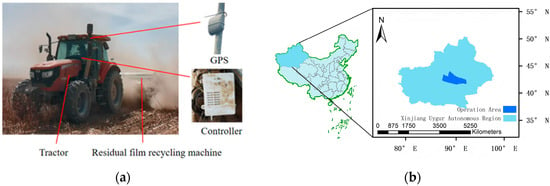
Figure 1
Open AccessArticle
Structural Analysis of Farming Systems in Western Macedonia: A Cluster-Based Approach
by
Theodoros Siogkas, Katerina Melfou, Georgia Koutouzidou, Efstratios Loizou and Athanasios Ragkos
Agriculture 2025, 15(15), 1650; https://doi.org/10.3390/agriculture15151650 - 31 Jul 2025
Abstract
This paper examines the farming systems and operational structures in the Region of Western Macedonia (RWM), Greece and constructs a typology of farms based on structural, operational, and socio-economic characteristics. Agriculture remains a vital pillar of the regional economy, particularly in the context
[...] Read more.
This paper examines the farming systems and operational structures in the Region of Western Macedonia (RWM), Greece and constructs a typology of farms based on structural, operational, and socio-economic characteristics. Agriculture remains a vital pillar of the regional economy, particularly in the context of RWM’s ongoing transition to a post-lignite development model. Using farm-level data from the 2018 Farm Accountancy Data Network (FADN), Principal Component Analysis (PCA) identified four latent dimensions of farm heterogeneity—income and productivity, asset base, land size, and labour structure. Hierarchical and K-means cluster analysis revealed three distinct farm types: (1) medium-sized, high-efficiency farms with moderate reliance on subsidies (30% of the sample); (2) small-scale, family farms with modest productivity and limited capitalisation (48%); and (3) large, asset-rich farms exhibiting structural inefficiencies and lower output per hectare (22%). These findings highlight structural vulnerabilities, particularly the predominance of undercapitalised smallholdings, and provide a data-driven foundation for Thdesigning differentiated policies that support farm resilience, generational renewal, and sustainable rural development.
Full article
(This article belongs to the Section Agricultural Economics, Policies and Rural Management)
►▼
Show Figures

Figure 1
Open AccessArticle
The RF–Absolute Gradient Method for Localizing Wheat Moisture Content’s Abnormal Regions with 2D Microwave Scanning Detection
by
Dong Dai, Zhenyu Wang, Hao Huang, Xu Mao, Yehong Liu, Hao Li and Du Chen
Agriculture 2025, 15(15), 1649; https://doi.org/10.3390/agriculture15151649 - 31 Jul 2025
Abstract
High moisture content (MC) harms wheat storage quality and readily leads to mold growth. Accurate localization of abnormal/high-moisture regions enables early warning, ensuring proper storage and reducing economic losses. The present study introduces the 2D microwave scanning method and investigates a novel localization
[...] Read more.
High moisture content (MC) harms wheat storage quality and readily leads to mold growth. Accurate localization of abnormal/high-moisture regions enables early warning, ensuring proper storage and reducing economic losses. The present study introduces the 2D microwave scanning method and investigates a novel localization method for addressing such a challenge. Both static and scanning experiments were performed on a developed mobile and non-destructive microwave detection system to quantify the MC of wheat and then locate abnormal moisture regions. For quantifying the wheat’s MC, a dual-parameter wheat MC prediction model with the random forest (RF) algorithm was constructed, achieving a high accuracy (R2 = 0.9846, MSE = 0.2768, MAE = 0.3986). MC scanning experiments were conducted by synchronized moving waveguides; the maximum absolute error of MC prediction was 0.565%, with a maximum relative error of 3.166%. Furthermore, both one- and two-dimensional localizing methods were proposed for localizing abnormal moisture regions. The one-dimensional method evaluated two approaches—attenuation value and absolute attenuation gradient—using computer simulation technology (CST) modeling and scanning experiments. The experimental results confirmed the superior performance of the absolute gradient method, with a center detection error of less than 12 mm in the anomalous wheat moisture region and a minimum width detection error of 1.4 mm. The study performed two-dimensional antenna scanning and effectively imaged the high-MC regions using phase delay analysis. The imaging results coincide with the actual locations of moisture anomaly regions. This study demonstrated a promising solution for accurately localizing the wheat’s abnormal/high-moisture regions with the use of an emerging microwave transmission method.
Full article
(This article belongs to the Section Agricultural Product Quality and Safety)
►▼
Show Figures
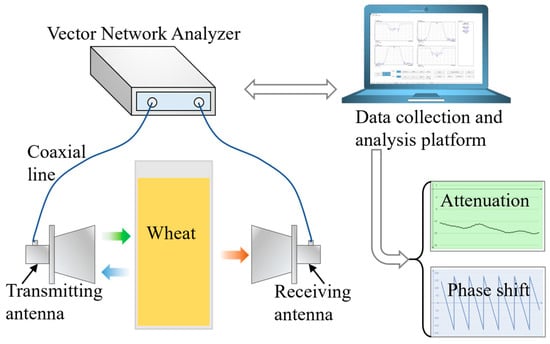
Figure 1
Open AccessArticle
Comparative Analysis of Pesticide Residues in Hive Products from Rapeseed (Brassica napus subsp. napus) and Sunflower (Helianthus annuus) Crops Under Varying Agricultural Practices in Romania During the 2020–2021 Beekeeping Seasons
by
Dan Bodescu, Viorel Fătu, Agripina Şapcaliu, Elena Luiza Bădic, Roxana Zaharia, Dana Tăpăloagă, Alexandru-Dragoș Robu and Radu-Adrian Moraru
Agriculture 2025, 15(15), 1648; https://doi.org/10.3390/agriculture15151648 - 31 Jul 2025
Abstract
Over the past years, increasing attention has been drawn to the adverse effects of agricultural pesticide use on pollinators, with honeybees being especially vulnerable. The aim of this study was to evaluate the levels of residues detectable and/or quantifiable of neonicotinoid pesticides and
[...] Read more.
Over the past years, increasing attention has been drawn to the adverse effects of agricultural pesticide use on pollinators, with honeybees being especially vulnerable. The aim of this study was to evaluate the levels of residues detectable and/or quantifiable of neonicotinoid pesticides and other pesticides in biological materials (bees, bee brood, etc.) and beehive products (honey, pollen, etc.) applied as seed dressings in rapeseed and sunflower plants in two growing seasons (2020–2021) in fields located in three agro-climatic regions in Romania. The study involved the comparative sampling of hive products (honey, pollen, adult bees, and brood) from experimental and control apiaries, followed by pesticide residue analysis in an accredited laboratory (Primoris) using validated chromatographic techniques (LC-MS/MS and GC-MS). Toxicological analyses of 96 samples, including bees, bee brood, honey, and pollen, confirmed the presence of residues in 46 samples, including 10 bee samples, 10 bee brood samples, 18 honey samples, and 8 pollen bread samples. The mean pesticide residue concentrations detected in hive products were 0.032 mg/kg in honey, 0.061 mg/kg in pollen, 0.167 mg/kg in bees, and 0.371 mg/kg in bee brood. The results highlight the exposure of honeybee colonies to multiple sources of pesticide residue contamination, under conditions where legal recommendations for the controlled application of agricultural treatments are not followed. The study provides relevant evidence for strengthening the risk assessment framework and underscores the need for adopting stricter monitoring and regulatory measures to ensure the protection of honeybee colony health.
Full article
(This article belongs to the Section Agricultural Product Quality and Safety)
►▼
Show Figures

Figure 1

Journal Menu
► ▼ Journal Menu-
- Agriculture Home
- Aims & Scope
- Editorial Board
- Reviewer Board
- Topical Advisory Panel
- Instructions for Authors
- Special Issues
- Topics
- Sections
- Article Processing Charge
- Indexing & Archiving
- Editor’s Choice Articles
- Most Cited & Viewed
- Journal Statistics
- Journal History
- Journal Awards
- Conferences
- Editorial Office
Journal Browser
► ▼ Journal BrowserHighly Accessed Articles
Latest Books
E-Mail Alert
News
Topics
Topic in
Agriculture, Atmosphere, Sustainability, Land, Environments, Agronomy, Energies
Greenhouse Gas Emission Reductions and Carbon Sequestration in Agriculture
Topic Editors: Dimitrios Aidonis, Dionysis Bochtis, Charisios AchillasDeadline: 31 August 2025
Topic in
Agriculture, Analytica, Chemistry, Environments, JoX
Exploring the Interplay of Agriculture, Analytical Chemistry, Environments and Toxics
Topic Editors: Bruno Lemos Batista, Tatiana Pedron, Camila Neves LangeDeadline: 20 September 2025
Topic in
Agriculture, Agronomy, Forests, Remote Sensing, Sustainability
Challenges, Development and Frontiers of Smart Agriculture and Forestry—2nd Volume
Topic Editors: Xiaoli Zhang, Dengsheng Lu, Xiujuan Chai, Guijun Yang, Langning HuoDeadline: 30 September 2025
Topic in
Agriculture, Agronomy, Crops, Land, Plants, Sustainability
Irrigation and Fertilization Management for Sustainable Agricultural Production
Topic Editors: Shihong Yang, Zewei Jiang, Ivan Francisco Garcia TejeroDeadline: 15 October 2025

Conferences
Special Issues
Special Issue in
Agriculture
Honey Bees and Wild Pollinators in Agricultural Ecosystems
Guest Editors: Roberto Bava, Fabio Castagna, Carmine LupiaDeadline: 10 August 2025
Special Issue in
Agriculture
Revolutionizing Sustainable Agriculture and Environmental Protection with Nanotechnology and Bioactive Compound
Guest Editors: Paola Fincheira, Gonzalo Tortella, Adalberto Benavides-Mendoza, Antonio Juárez-MaldonadoDeadline: 10 August 2025
Special Issue in
Agriculture
Agroforestry Systems: Strategies for Mitigating Climate Change
Guest Editor: Bhim Bahadur GhaleyDeadline: 15 August 2025
Special Issue in
Agriculture
Bioremediation of Contaminated Soil, Wastewater and Biowaste in Agricultural System
Guest Editors: Alba Lara-Moreno, Fernando MadridDeadline: 15 August 2025










